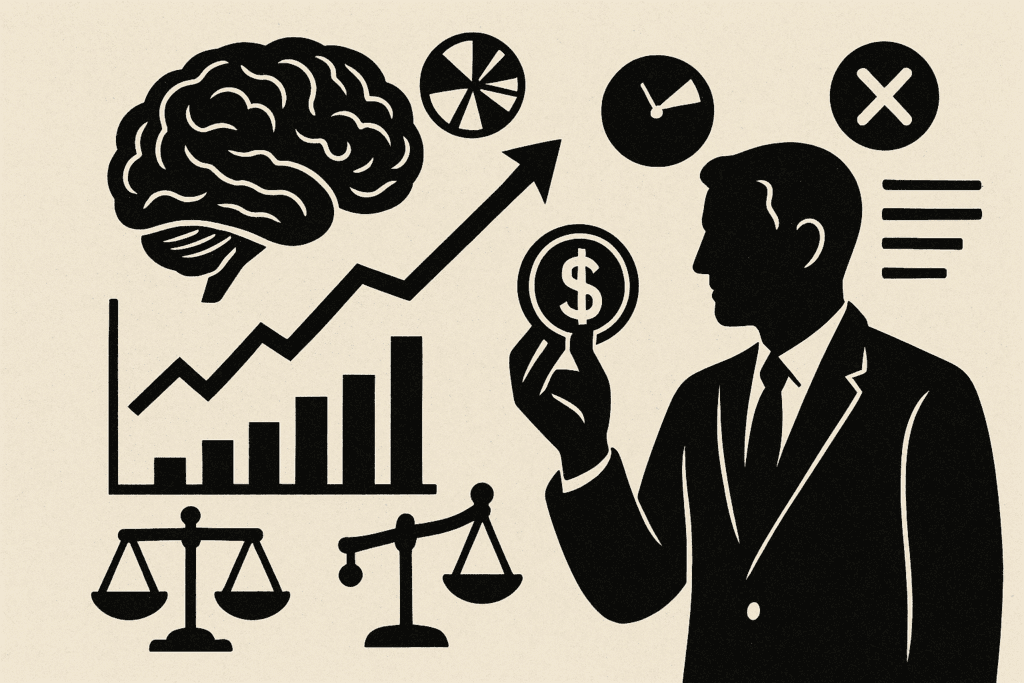By The Milk News Desk
New York City – August 18, 2025
In an era where retail investors have unprecedented access to markets, behavioral finance—the study of how psychological factors impact investment decisions—is taking center stage. As millions flocked to online trading platforms during and after the pandemic, financial professionals are realizing that understanding human behavior is just as critical as parsing earnings reports or macroeconomic data.

After three decades covering markets and two years of unprecedented retail trading volumes, I’ve witnessed countless individual investors make the same costly mistakes over and over. But there’s a growing cohort that’s cracked the code—and their secret isn’t superior stock-picking or market timing. It’s mastering their own psychology.
The numbers tell a stark story. While the S&P 500 delivered annualized returns of roughly 10% over the past decade, the average retail investor earned just 3.6%, according to fresh analysis from investment research firm Dalbar. The culprit? Behavioral biases that turn rational people into their own worst investment enemies.
“I used to think successful investing was about finding the next Amazon or Tesla,” says Gonzalez, a 34-year-old software engineer from Austin who transformed her portfolio performance after discovering behavioral finance principles in 2023. “Now I realize it was about finding ways to outsmart my own brain.”
Gonzalez’s revelation mirrors a broader awakening among individual investors. Robo-advisors and investment apps increasingly integrate behavioral nudges, while financial advisors report that clients who understand cognitive biases consistently outperform those who don’t.
The Psychology of Money Mistakes
During my recent conversations with behavioral finance experts, a clear pattern emerged: retail investors consistently fall victim to the same psychological traps, regardless of education or income level.
Loss aversion—the tendency to feel losses twice as intensely as equivalent gains—drives panic selling during market downturns. Confirmation bias leads investors to seek information that validates existing positions while ignoring contrary evidence. And the availability heuristic causes people to overweight recent events, explaining why many investors pile into assets after they’ve already surged.
“Traditional finance assumes people are rational calculators,” explains Dr. Chen, a behavioral economist who consults for several fintech firms. “But real humans are emotional, prone to shortcuts, and terrible at probability. Once investors acknowledge this, they can build systems to work with their psychology, not against it.”
The insight is reshaping how successful retail investors approach markets. Instead of fighting human nature, they’re designing investment processes that account for it.
The Behavioral Finance Toolkit
Smart money has quietly adopted behavioral finance strategies that institutional investors have used for years. The most effective approaches I’ve encountered focus on three core principles:
Systematic Decision-Making: Top-performing retail investors create rules-based systems that remove emotion from investment choices. This might mean automatically rebalancing portfolios quarterly, regardless of market conditions, or using dollar-cost averaging to eliminate timing decisions.
Pre-Commitment Strategies: Successful investors make decisions about future actions when they’re thinking clearly, not in the heat of market stress. Setting stop-loss orders, establishing asset allocation targets, and creating written investment policies all fall into this category.
Environmental Design: The best retail investors structure their financial environments to encourage good behavior and discourage bad habits. This includes everything from automating contributions to avoiding financial news during volatile periods.
Real-World Results
The proof is in performance. Take Robert, a 42-year-old teacher from Seattle, who began applying behavioral finance concepts after losing 40% of his portfolio during the 2022 market downturn.
“I realized I was making emotional decisions disguised as analytical ones,” Robert tells me. “I’d research companies obsessively after buying their stock, ignoring negative information while amplifying anything positive. I was basically being my own confirmation bias machine.”
Robert now follows a strict set of behavioral rules: He invests the same amount monthly regardless of market conditions, rebalances annually on his birthday, and has a trusted friend review any investment decision over $5,000. His portfolio has outperformed the market by 2.3 percentage points annually since implementing these changes.
Stories like Robert’s are becoming increasingly common. Financial advisors report that clients who complete behavioral bias assessments and implement corresponding strategies show measurably better investment outcomes.
The Institutional Advantage Narrows
Perhaps most significantly, behavioral finance is leveling the playing field between retail and institutional investors. Professional money managers have always had advantages—better research, faster execution, larger scale. But they’re just as susceptible to psychological biases as individual investors.
“Institutional investors still panic during crashes and get euphoric during bubbles,” notes Michael, a former hedge fund manager who now coaches high-net-worth individuals. “The difference is they have systems and processes that limit the damage from their psychological mistakes. Retail investors can build similar systems.”
This democratization of behavioral finance tools explains part of retail investors’ improved performance in recent years. Apps like Betterment and Wealthfront use behavioral nudges to encourage better investor behavior, while platforms like Schwab and Fidelity now offer behavioral bias assessments and personalized recommendations.
The Path Forward
As I look ahead to the remainder of 2025, behavioral finance appears poised to become even more critical for retail investor success. Market volatility isn’t disappearing, and the proliferation of investment options—from crypto to private markets—creates more opportunities for psychological mistakes.
But the investors who master their own psychology will likely find unprecedented opportunity. The combination of accessible behavioral finance education, technology that supports better decision-making, and markets that reward patient, systematic approaches creates conditions for retail investor success unlike any I’ve seen in my career.
The question isn’t whether behavioral finance will become more important—it’s whether individual investors will be wise enough to embrace it before their emotions cost them their financial futures.
[2-3 industry veterans written this article and their experience, used AI also, please consult your financial advisor]
